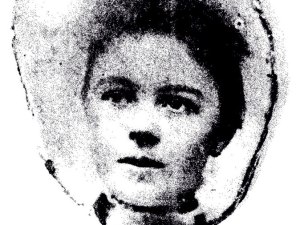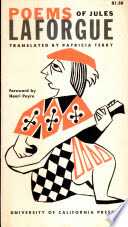The story of Leah Lee and Jules Laforgue has been written as an ‘informal’ biography Looking for Laforgue (1979) by journalist David Arkell. It was he who discovered, in 1965, the identity of Laforgue’s wife and among the many photographs and drawings in this volume are a photograph of Leah Lee, of her tombstone in the churchyard in Teignmouth, and a reproduction of an extract from The Teignmouth Gazette showing an advertisement for S. Lee’s Paris Wove Corsets, for she was the daughter of a well-to-do draper.
Leah has been described as “a black-eyed, chestnut-haired Devonshire beauty”. Born in 1861, she was the daughter of the draper Samuel Lee and his wife, also named Leah. Her story is quite extraordinary – a young Victorian woman who left the small town of Teignmouth and England to become governess to the children of Empress Augusta in Berlin. It was there that she met the young Frenchman, Jules Laforgue, who was a poet and a Reader in French to the Empress Augusta.
Laforgue was a handsome cigar-smoking dandy who relished the opportunity to wear frock coats, toppers, and morning dress when he went over to sit with the old empress and read her the tony Revue des deux mondes in the language she preferred to German – just the thing for an artist whose parents weren’t rich. During 1883 he had a stormy affair with a mysterious woman known only as ‘R’, believed to be a German woman twice his age who was a Woman of the Royal Wardrobe.
But for a long time he had admired Englishwomen – he once wrote to a friend “As you know, there are three sexes – men, women and English girls”. So perhaps it is no surprise that he started to take English lessons from Leah, whom he called his “Petit Personage”. She was impossible to describe, he informed his sister: “imagine a baby face, with a malicious smile and big eyes (tar-coloured) always astonished, and a little voice, and a funny little accent in French”. This was the start of a change in his life and his poetical focus. It appears they had a whirlwind romance, left Berlin, got married on December 31st 1886 in England at the Church of St Barnabas in Kensington and then returned to Paris where Jules Laforgue could immerse himself in the cultural maelstrom that was Paris in the 1880s.
During 1886 there was a burst of creativity; the interesting women in Laforgue’s new poems, Des fleurs de bonne volonte, and his stories, Moralités légendaires, are perhaps his finest achievement. Leah became the model for his tender portrait of the red-headed Andromede, an impatient girl who declines to be rescued from a vulnerable dragon by a smug hero.
Less than a year later Jules was dead (20th August 1887), having contracted TB. Leah died a year later (6th June 1888) from the same disease. Leah was in London when she died but was buried in the main cemetery off Exeter Road in Teignmouth.
Before she died though, Leah, who had kept all of Jules’s manuscripts, handed them over to a friend, Teodor de Wyzewa, in Jules’s literary circle. This ensured that his work lived on to become the primary influence in modern poetry.
Laforgue’s poetic output includes Les complaintes (1885), L’Imitation de Notre Dame de la lune (1886), and his masterpiece, Derniers vers (1890). He also produced some short prose pieces, notably Moralités légendaires (1887).
Jules Laforgue was no ordinary poet. He is widely recognised as the father of modern poetry and the creator of “free verse” or “vers libre” as it was known at the time. French poetry was particularly rigorous, with strict rules of rhyme and scansion so Laforgue was breaking all the rules. He was the Impressionist or Cubist of poetry – “I forget to rhyme,” Laforgue wrote, “I forget the number of syllables, I forget to set it in stanzas – the lines themselves begin in the margin like prose. The old regular stanza only turns up when a popular quatrain is needed.”
Modern poetry was launched in France in 1886 with the launch of La Vogue whose first issue was confiscated for obscenity (note that Laforgue was the first French poet to use the word “clitoris” in verse) and only lasted 20 issues. But this “little magazine” contained the most powerfully influential work of the three “onlie begetters” of Modern poetry: Walt Whitman, Arthur Rimbaud and Jules Laforgue.
T S Eliot discovered Laforgue in 1908 when he was at Harvard and it changed his life. Eliot’s reading of Laforgue that summer changed his style completely, sent him to Paris, and emancipated him from the last traces of Victorian America’s genteel style. It may have turned him into a poet. Eliot’s first book of poems, Prufrock and other observations, owes its very existence to Laforgue’s magnetism. Pound marvelled that Eliot was the only writer he met who had “modernised himself on his own;” but if he had tried to do it without Laforgue, it is unlikely he would have been anything other than a professor of philosophy. Eliot said “Laforgue was the first to teach me how to speak, to teach me the poetic possibilities of my own idiom of speech”. Eliot was so influenced by Laforgue that he even married his wife Valerie in the same church, St Barnabas, where Leah and Jules were wed.
Ezra Pound described Laforgue as “an angel with whom our modern poetic Jacob must struggle,” and “perhaps the most sophisticated of all French poets”; in 1913 he added, “Practically the whole development of the English verse-art has been achieved by steals from the French.”
The above has been collated from various sources:
Wikipedia
TS Eliot, The Varieties of Metaphysical Poetry
Rylands Archives
Times Literary Supplement
The Imperfect Life of TS Eliot
The First Moderns
Poems of Jules Laforgue




